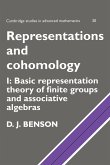Albert Burroni, Dimitri Ara, Francois Metayer, Philippe Malbos, Samuel Mimram, Yves Guiraud
Polygraphs: From Rewriting to Higher Categories
Albert Burroni, Dimitri Ara, Francois Metayer, Philippe Malbos, Samuel Mimram, Yves Guiraud
Polygraphs: From Rewriting to Higher Categories
- Broschiertes Buch
- Merkliste
- Auf die Merkliste
- Bewerten Bewerten
- Teilen
- Produkt teilen
- Produkterinnerung
- Produkterinnerung
This book, intended for PhD students and researchers, revisits the theory of rewriting and presentations of algebraic structures, through the unified approach provided by polygraphs, and put it in the context of homotopical algebra. It introduces the theory step-by-step using low-dimensional illustrations, providing detailed proofs.
Andere Kunden interessierten sich auch für
![C∞-Algebraic Geometry with Corners C∞-Algebraic Geometry with Corners]() Kelli Francis-StaiteC∞-Algebraic Geometry with Corners88,99 €
Kelli Francis-StaiteC∞-Algebraic Geometry with Corners88,99 €![Introduction to Analytical Geometry Introduction to Analytical Geometry]() A. RobsonIntroduction to Analytical Geometry54,99 €
A. RobsonIntroduction to Analytical Geometry54,99 €![Representations and Cohomology Representations and Cohomology]() D. BensonRepresentations and Cohomology85,99 €
D. BensonRepresentations and Cohomology85,99 €![Representations and Cohomology Representations and Cohomology]() D. BensonRepresentations and Cohomology49,99 €
D. BensonRepresentations and Cohomology49,99 €![Principles of Geometry Principles of Geometry]() H. F. BakerPrinciples of Geometry41,99 €
H. F. BakerPrinciples of Geometry41,99 €![Principles of Geometry Principles of Geometry]() H. F. BakerPrinciples of Geometry41,99 €
H. F. BakerPrinciples of Geometry41,99 €![Typical Dynamics of Volume Preserving Homeomorphisms Typical Dynamics of Volume Preserving Homeomorphisms]() Alpern SteveTypical Dynamics of Volume Preserving Homeomorphisms29,99 €
Alpern SteveTypical Dynamics of Volume Preserving Homeomorphisms29,99 €-
-
-
This book, intended for PhD students and researchers, revisits the theory of rewriting and presentations of algebraic structures, through the unified approach provided by polygraphs, and put it in the context of homotopical algebra. It introduces the theory step-by-step using low-dimensional illustrations, providing detailed proofs.
Hinweis: Dieser Artikel kann nur an eine deutsche Lieferadresse ausgeliefert werden.
Hinweis: Dieser Artikel kann nur an eine deutsche Lieferadresse ausgeliefert werden.
Produktdetails
- Produktdetails
- Verlag: Cambridge University Press
- Seitenzahl: 666
- Erscheinungstermin: 31. März 2025
- Englisch
- ISBN-13: 9781009498982
- ISBN-10: 1009498983
- Artikelnr.: 72110730
- Herstellerkennzeichnung
- Produktsicherheitsverantwortliche/r
- Europaallee 1
- 36244 Bad Hersfeld
- gpsr@libri.de
- Verlag: Cambridge University Press
- Seitenzahl: 666
- Erscheinungstermin: 31. März 2025
- Englisch
- ISBN-13: 9781009498982
- ISBN-10: 1009498983
- Artikelnr.: 72110730
- Herstellerkennzeichnung
- Produktsicherheitsverantwortliche/r
- Europaallee 1
- 36244 Bad Hersfeld
- gpsr@libri.de
Dimitri Ara is Associate Professor at Aix-Marseille Université.
Part I. Fundamentals of Rewriting: 1. Abstract rewriting and one-dimensional polygraphs; 2. Two-dimensional polygraphs; 3. Operations on presentations; 4. String rewriting and 2-polygraphs; 5. Tietze transformations and completion; 6. Linear rewriting; Part II. Coherent Presentations: 7. Coherence by convergence; 8. Categories of finite derivation type; 9. Homological syzygies and confluence; Part III. Diagram Rewriting: 10. Three-dimensional polygraphs; 11. Termination of 3-polygraphs; 12. Coherent presentations of 2-categories; 13. Term rewriting systems; Part IV. Polygraphs: 14. Higher categories; 15. Polygraphs; 16. Properties of the category of
-polygraphs; 17. A catalogue of
-polygraphs; 18. Generalized polygraphs; Part V. Homotopy Theory of Polygraphs; 19. Polygraphic resolutions; 20. Towards the folk model structure; 21. The folk model structure; 22. Homology of
-categories; 23. Resolutions by (
, 1)-polygraphs; Appendix A. A catalogue of 2-polygraphs; Appendix B. Examples of coherent presentations of monoids; Appendix C. A catalogue of 3-polygraphs; Appendix D. A syntactic description of free
-categories; Appendix E. Complexes and homology; Appendix F. Homology of categories; Appendix G. Locally presentable categories; Appendix H. Model categories; References; Index of notations; Index of terminology.Part I. Fundamentals of Rewriting: 1. Abstract rewriting and one-dimensional polygraphs; 2. Two-dimensional polygraphs; 3. Operations on presentations; 4. String rewriting and 2-polygraphs; 5. Tietze transformations and completion; 6. Linear rewriting; Part II. Coherent Presentations: 7. Coherence by convergence; 8. Categories of finite derivation type; 9. Homological syzygies and confluence; Part III. Diagram Rewriting: 10. Three-dimensional polygraphs; 11. Termination of 3-polygraphs; 12. Coherent presentations of 2-categories; 13. Term rewriting systems; Part IV. Polygraphs: 14. Higher categories; 15. Polygraphs; 16. Properties of the category of
-polygraphs; 17. A catalogue of
-polygraphs; 18. Generalized polygraphs; Part V. Homotopy Theory of Polygraphs: 19. Polygraphic resolutions; 20. Towards the folk model structure; 21. The folk model structure; 22. Homology of
-categories; 23. Resolutions by (
, 1)-polygraphs; Appendix A. A catalogue of 2-polygraphs; Appendix B. Examples of coherent presentations of monoids; Appendix C. A catalogue of 3-polygraphs; Appendix D. A syntactic description of free
-categories; Appendix E. Complexes and homology; Appendix F. Homology of categories; Appendix G. Locally presentable categories; Appendix H. Model categories; References; Index of notations; Index of terminology.
-polygraphs; 17. A catalogue of
-polygraphs; 18. Generalized polygraphs; Part V. Homotopy Theory of Polygraphs; 19. Polygraphic resolutions; 20. Towards the folk model structure; 21. The folk model structure; 22. Homology of
-categories; 23. Resolutions by (
, 1)-polygraphs; Appendix A. A catalogue of 2-polygraphs; Appendix B. Examples of coherent presentations of monoids; Appendix C. A catalogue of 3-polygraphs; Appendix D. A syntactic description of free
-categories; Appendix E. Complexes and homology; Appendix F. Homology of categories; Appendix G. Locally presentable categories; Appendix H. Model categories; References; Index of notations; Index of terminology.Part I. Fundamentals of Rewriting: 1. Abstract rewriting and one-dimensional polygraphs; 2. Two-dimensional polygraphs; 3. Operations on presentations; 4. String rewriting and 2-polygraphs; 5. Tietze transformations and completion; 6. Linear rewriting; Part II. Coherent Presentations: 7. Coherence by convergence; 8. Categories of finite derivation type; 9. Homological syzygies and confluence; Part III. Diagram Rewriting: 10. Three-dimensional polygraphs; 11. Termination of 3-polygraphs; 12. Coherent presentations of 2-categories; 13. Term rewriting systems; Part IV. Polygraphs: 14. Higher categories; 15. Polygraphs; 16. Properties of the category of
-polygraphs; 17. A catalogue of
-polygraphs; 18. Generalized polygraphs; Part V. Homotopy Theory of Polygraphs: 19. Polygraphic resolutions; 20. Towards the folk model structure; 21. The folk model structure; 22. Homology of
-categories; 23. Resolutions by (
, 1)-polygraphs; Appendix A. A catalogue of 2-polygraphs; Appendix B. Examples of coherent presentations of monoids; Appendix C. A catalogue of 3-polygraphs; Appendix D. A syntactic description of free
-categories; Appendix E. Complexes and homology; Appendix F. Homology of categories; Appendix G. Locally presentable categories; Appendix H. Model categories; References; Index of notations; Index of terminology.
Part I. Fundamentals of Rewriting: 1. Abstract rewriting and one-dimensional polygraphs; 2. Two-dimensional polygraphs; 3. Operations on presentations; 4. String rewriting and 2-polygraphs; 5. Tietze transformations and completion; 6. Linear rewriting; Part II. Coherent Presentations: 7. Coherence by convergence; 8. Categories of finite derivation type; 9. Homological syzygies and confluence; Part III. Diagram Rewriting: 10. Three-dimensional polygraphs; 11. Termination of 3-polygraphs; 12. Coherent presentations of 2-categories; 13. Term rewriting systems; Part IV. Polygraphs: 14. Higher categories; 15. Polygraphs; 16. Properties of the category of
-polygraphs; 17. A catalogue of
-polygraphs; 18. Generalized polygraphs; Part V. Homotopy Theory of Polygraphs; 19. Polygraphic resolutions; 20. Towards the folk model structure; 21. The folk model structure; 22. Homology of
-categories; 23. Resolutions by (
, 1)-polygraphs; Appendix A. A catalogue of 2-polygraphs; Appendix B. Examples of coherent presentations of monoids; Appendix C. A catalogue of 3-polygraphs; Appendix D. A syntactic description of free
-categories; Appendix E. Complexes and homology; Appendix F. Homology of categories; Appendix G. Locally presentable categories; Appendix H. Model categories; References; Index of notations; Index of terminology.Part I. Fundamentals of Rewriting: 1. Abstract rewriting and one-dimensional polygraphs; 2. Two-dimensional polygraphs; 3. Operations on presentations; 4. String rewriting and 2-polygraphs; 5. Tietze transformations and completion; 6. Linear rewriting; Part II. Coherent Presentations: 7. Coherence by convergence; 8. Categories of finite derivation type; 9. Homological syzygies and confluence; Part III. Diagram Rewriting: 10. Three-dimensional polygraphs; 11. Termination of 3-polygraphs; 12. Coherent presentations of 2-categories; 13. Term rewriting systems; Part IV. Polygraphs: 14. Higher categories; 15. Polygraphs; 16. Properties of the category of
-polygraphs; 17. A catalogue of
-polygraphs; 18. Generalized polygraphs; Part V. Homotopy Theory of Polygraphs: 19. Polygraphic resolutions; 20. Towards the folk model structure; 21. The folk model structure; 22. Homology of
-categories; 23. Resolutions by (
, 1)-polygraphs; Appendix A. A catalogue of 2-polygraphs; Appendix B. Examples of coherent presentations of monoids; Appendix C. A catalogue of 3-polygraphs; Appendix D. A syntactic description of free
-categories; Appendix E. Complexes and homology; Appendix F. Homology of categories; Appendix G. Locally presentable categories; Appendix H. Model categories; References; Index of notations; Index of terminology.
-polygraphs; 17. A catalogue of
-polygraphs; 18. Generalized polygraphs; Part V. Homotopy Theory of Polygraphs; 19. Polygraphic resolutions; 20. Towards the folk model structure; 21. The folk model structure; 22. Homology of
-categories; 23. Resolutions by (
, 1)-polygraphs; Appendix A. A catalogue of 2-polygraphs; Appendix B. Examples of coherent presentations of monoids; Appendix C. A catalogue of 3-polygraphs; Appendix D. A syntactic description of free
-categories; Appendix E. Complexes and homology; Appendix F. Homology of categories; Appendix G. Locally presentable categories; Appendix H. Model categories; References; Index of notations; Index of terminology.Part I. Fundamentals of Rewriting: 1. Abstract rewriting and one-dimensional polygraphs; 2. Two-dimensional polygraphs; 3. Operations on presentations; 4. String rewriting and 2-polygraphs; 5. Tietze transformations and completion; 6. Linear rewriting; Part II. Coherent Presentations: 7. Coherence by convergence; 8. Categories of finite derivation type; 9. Homological syzygies and confluence; Part III. Diagram Rewriting: 10. Three-dimensional polygraphs; 11. Termination of 3-polygraphs; 12. Coherent presentations of 2-categories; 13. Term rewriting systems; Part IV. Polygraphs: 14. Higher categories; 15. Polygraphs; 16. Properties of the category of
-polygraphs; 17. A catalogue of
-polygraphs; 18. Generalized polygraphs; Part V. Homotopy Theory of Polygraphs: 19. Polygraphic resolutions; 20. Towards the folk model structure; 21. The folk model structure; 22. Homology of
-categories; 23. Resolutions by (
, 1)-polygraphs; Appendix A. A catalogue of 2-polygraphs; Appendix B. Examples of coherent presentations of monoids; Appendix C. A catalogue of 3-polygraphs; Appendix D. A syntactic description of free
-categories; Appendix E. Complexes and homology; Appendix F. Homology of categories; Appendix G. Locally presentable categories; Appendix H. Model categories; References; Index of notations; Index of terminology.








